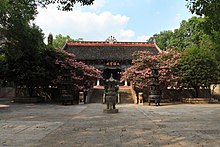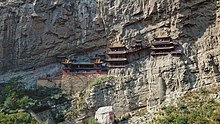
Mount Wutai, also known by its Chinese name Wutaishan and as Mount Qingliang, is a sacred Buddhist site at the headwaters of the Qingshui in Shanxi Province, China. Its central area is surrounded by a cluster of flat-topped peaks or mesas roughly corresponding to the cardinal directions. The north peak is the highest and is also the highest point in North China.
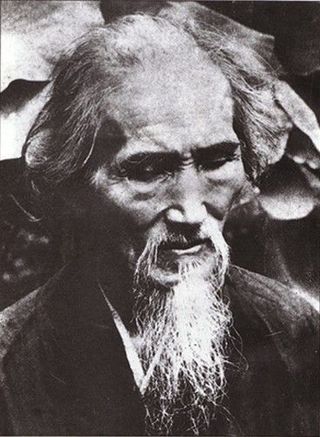
Xuyun or Hsu Yun was a renowned Chinese Chan Buddhist master and an influential Buddhist teacher of the 19th and 20th centuries.

Bodhimaṇḍa or daochang is a term used in Buddhism meaning the "position of awakening". According to Haribhadra, it is "a place used as a seat, where the essence of enlightenment is present".

Mount Jiuhua located in Chizhou, Anhui Province in China is an important Buddhist site and natural scenic spot. It is one of the four famous Buddhist mountains in China, one of the first batch of 5A level scenic spots in China, one of the first batch of natural and cultural heritage sites in China, and the main scenic spot of "two mountains and one lake" tourism development strategy in Anhui Province. The planned area of the scenic spot is 120 square kilometers, and the protected area is 174 square kilometers, which is composed of 11 scenic spots.
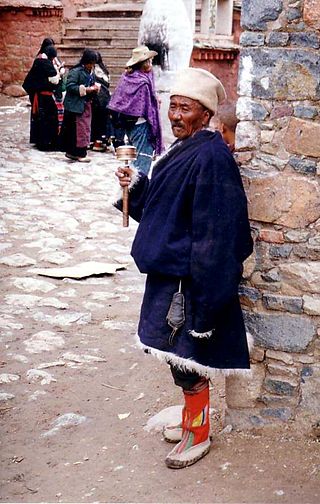
The most important places in Buddhism are located in the Indo-Gangetic Plain of southern Nepal and northern India. This is the area where Gautama Buddha was born, lived, and taught, and the main sites connected to his life are now important places of pilgrimage for both Buddhists and Hindus. Many countries that are or were predominantly Buddhist have shrines and places which can be visited as a pilgrimage.

The Pagoda of Cishou Temple, originally known as Yong'an Wanshou Pagoda, is a 16th-century stone and brick Chinese pagoda located in the Buddhist Cishou Temple in Balizhuang, Haidian District, Beijing.

The Tianning Temple is a Buddhist temple complex located in Xicheng District of Beijing, in northern China.

Foguang Temple is a Buddhist temple located five kilometres from Doucun, Wutai County, Shanxi Province of China. The major hall of the temple is the Great East Hall, built in 857 AD, during the Tang dynasty (618–907). According to architectural records, it is the third earliest preserved timber structure in China. It was rediscovered by the 20th-century architectural historian Liang Sicheng (1901–1972) in 1937, while an older hall at Nanchan Temple was discovered by the same team a year later. The temple also contains another significant hall dating from 1137 called the Manjusri Hall. In addition, the second oldest existing pagoda in China, dating from the 6th century, is located in the temple grounds. Today the temple is part of a UNESCO World Heritage site and is undergoing restoration.

Nanchan Temple is a Buddhist temple located near the town of Doucun on Mount Wutai, Shanxi, China. Nanchan Temple was built in 782 during China's Tang dynasty, and its Great Buddha Hall is currently China's oldest preserved timber building extant, as wooden buildings are often prone to fire and various destruction. Not only is Nanchan Temple an important architectural site, but it also contains an original set of artistically important Tang sculptures dating from the period of its construction. Seventeen sculptures share the hall's interior space with a small stone pagoda.
National Key Buddhist Temples in Han Chinese Area are national key ("important") Buddhist temples in areas traditionally associated with the Han Chinese in the People's Republic of China. The list was originally released on 9 April 1983 by the State Council, and included 142 Buddhist temples, of which all in the original list are listed below.
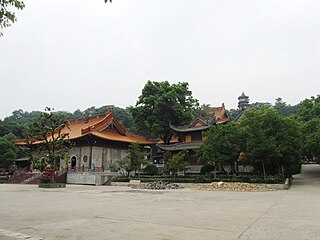
Guangji Temple is a Buddhist temple located on the southwest hillside of Mount Zhe, in Jinghu District of Wuhu, Anhui, China. Alongside Puji Temple, Nengren Temple and Jixiang Temple, Guangji Temple is known as one of the "Four Buddhist Temples in Wuhu". Guangji Temple has been praised as "Little Mount Jiuhua". Guangji Temple experienced expansion and repair for many times and now still maintain the basic architectural pattern of the Ming and Qing dynasties (1368–1911).

The Shrine of Living Buddha is a Buddhist temple located at the Divine Light Summit (神光岭) of Mount Jiuhua, in Qingyang County, Anhui, China.
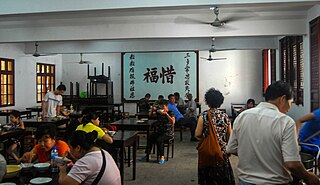
Huiji Temple is a Buddhist temple located on Mount Putuo, in Zhoushan, Zhejiang, China. Huiji Temple is commonly called the temple on the Buddha Summit and it is the third largest Buddhist temple on Mount Putuo, after Puji Temple and Fayu Temple.

Jinshan Temple is a Buddhist temple located in Runzhou District of Zhenjiang, Jiangsu, China.
Shifang Temple, also known as Guangren Temple, is a Buddhist temple located on Mount Wutai, in Taihuai Town of Wutai County, Shanxi, China.
Shanxi architecture, or Shansi architecture, or Jin architecture, refers to the architectural style of the Shanxi province in northern China. Shanxi has preserved numerous ancient architectures scattered throughout the province. All of the four remaining wooden structures preserved from Tang dynasty in China are found in Shanxi. The old buildings of Pingyao ancient city and numerous family compounds of Shanxi merchants in the Ming and Qing dynasties are representative of the architecture styles of vernacular architecture in North China. Religious temples in Mount Wutai and Yungang Grottoes in Datong exemplify the sacred buddhist architecture in China.






